Ford Transit Connect 2002 2007 User Manual

Owner's handbook
FordTourneoConnect FordTransitConnect
100% Ford. 100% Enjoyment.

The information contained in this publication was correct at the time of going to print. In the interest of development the right is reserved to change specifications, design or equipment at any time without notice and without incurring any obligations. This publication, or part thereof, may not be reproduced nor translated without our approval. Errors and omissions excepted.
© Ford Motor Company 2006
All rights reserved.
Part number: 7T1J-19A321-DA (CG3526en) 06/2006 20060720145026

Table of contents
Introduction |
|
About this handbook........................ |
5 |
Symbols glossary.............................. |
5 |
Parts and accessories...................... |
5 |
Quick start |
|
Child safety |
|
Child seats........................................ |
10 |
Child seat positioning....................... |
11 |
Booster cushions............................. |
14 |
ISOFIX anchor points....................... |
15 |
Child safety locks............................. |
17 |
Occupant protection |
|
Principle of operation...................... |
18 |
Fastening the seat belts................ |
22 |
Seat belt height adjustment.......... |
23 |
Using seat belts during |
|
pregnancy.................................... |
23 |
Arming the engine immobiliser |
.....34 |
Disarming the engine |
|
immobiliser................................... |
35 |
Alarm |
|
Arming the alarm............................. |
36 |
Disarming the alarm........................ |
36 |
Steering wheel |
|
Adjusting the steering wheel......... |
37 |
Audio control.................................... |
37 |
Wipers and washers |
|
Windscreen wipers......................... |
39 |
Windscreen washers..................... |
39 |
Rear window wiper and |
|
washers........................................ |
39 |
Adjusting the windscreen washer |
|
jets................................................. |
40 |
Checking the wiper blades........... |
40 |
Changing the wiper blades............ |
41 |
Keys and remote |
|
controls |
|
General information on radio |
|
frequencies.................................. |
24 |
Programming the remote |
|
control........................................... |
24 |
Changing the remote control |
|
battery........................................... |
25 |
Locks |
|
Locking and unlocking................... |
26 |
Engine immobiliser |
|
Principle of operation..................... |
33 |
Coded keys..................................... |
33 |
Lighting |
|
Lighting control................................ |
42 |
Front fog lamps............................... |
42 |
Rear fog lamps................................ |
42 |
Headlamp levelling.......................... |
43 |
Hazard warning flashers................ |
45 |
Direction indicators......................... |
46 |
Interior lamps................................... |
46 |
Changing a bulb.............................. |
47 |
Windows and mirrors |
|
Electric windows............................. |
52 |
Exterior mirrors................................ |
52 |
1

Table of contents
Electric exterior mirrors.................. |
53 |
Interior mirror................................... |
53 |
Rear quarter windows................... |
54 |
Instruments |
|
Instrument panel overview............ |
55 |
Gauges............................................. |
59 |
Warning lamps and indicators...... |
60 |
Audible warnings and |
|
indicators...................................... |
63 |
Climate control |
|
Principle of operation..................... |
64 |
Air vents............................................ |
65 |
Heated windows and mirrors....... |
65 |
Manual climate control................... |
66 |
Auxiliary heater................................ |
69 |
Seat back trays................................ |
87 |
Starting the engine |
|
General information........................ |
88 |
Ignition switch.................................. |
88 |
Starting a petrol engine.................. |
88 |
Starting a diesel engine.................. |
89 |
Switching off the engine................ |
89 |
Fuel and refuelling |
|
Safety precautions.......................... |
90 |
Fuel quality - Petrol......................... |
90 |
Fuel quality - Diesel......................... |
90 |
Catalytic converter......................... |
90 |
Fuel filler flap..................................... |
91 |
Refuelling........................................... |
91 |
Technical specifications.................. |
91 |
Seats |
|
Sitting in the correct position......... |
74 |
Front seats....................................... |
74 |
Head restraints................................ |
78 |
Rear seats........................................ |
78 |
Heated seats.................................... |
81 |
Convenience features |
|
Sun visors......................................... |
82 |
Clock................................................. |
82 |
Cigar lighter...................................... |
82 |
Ashtray.............................................. |
83 |
Auxiliary power sockets................. |
83 |
Glove box......................................... |
84 |
Centre console................................ |
84 |
Storage compartments................. |
85 |
Map pockets................................... |
86 |
Transmission |
|
Manual transmission....................... |
93 |
Brakes |
|
Principle of operation..................... |
94 |
Hints on driving with ABS............... |
94 |
Parking brake.................................. |
95 |
Parking aid |
|
Principle of operation..................... |
96 |
Using the parking aid...................... |
96 |
Load carrying |
|
General information........................ |
97 |
Roof racks and load carriers......... |
97 |
Cargo nets....................................... |
97 |
2

Table of contents
Towing |
|
Towing a trailer................................ |
99 |
Driving hints |
|
General driving points................... |
100 |
Running-in...................................... |
100 |
Emergency |
|
equipment |
|
First aid kit........................................ |
101 |
Warning triangle.............................. |
101 |
Status after a |
|
collision |
|
Fuel cut-off switch......................... |
102 |
Inspecting safety system |
|
components............................... |
102 |
Fuses |
|
Fuse box locations........................ |
103 |
Changing a fuse............................ |
104 |
Fuse labels...................................... |
104 |
Fuse specification chart............... |
106 |
Vehicle recovery |
|
Towing points................................. |
108 |
Towing the vehicle on four |
|
wheels......................................... |
109 |
Maintenance |
|
General information....................... |
110 |
Opening and closing the |
|
bonnet........................................... |
111 |
Engine compartment overview - |
|
1.8L Duratec-DOHC (Zetec)..... |
112 |
Engine compartment overview - |
|
1.8L Duratorq-TDDi (Kent) |
|
Diesel/1.8L Duratorq-TDCi (Kent) |
|
Diesel............................................ |
113 |
Engine oil check............................. |
114 |
Engine coolant check.................... |
115 |
Brake and clutch fluid check........ |
116 |
Power steering fluid check........... |
117 |
Washer fluid check......................... |
117 |
Technical specifications................. |
117 |
Vehicle care |
|
Cleaning the exterior..................... |
119 |
Cleaning the interior....................... |
119 |
Repairing minor paint damage..... |
120 |
Vehicle battery |
|
Battery care.................................... |
121 |
Using booster cables.................... |
121 |
Changing the vehicle battery...... |
122 |
Wheels and tyres |
|
Changing a road wheel................ |
123 |
Tyre care......................................... |
128 |
Using snow chains........................ |
129 |
Technical specifications................ |
129 |
Vehicle identification |
|
Vehicle identification plate............ |
132 |
Vehicle identification number |
|
(VIN)............................................. |
132 |
Engine number.............................. |
132 |
Load apportioning valve (LAV) |
|
plate............................................. |
132 |
3

Table of contents
Technical specifications
Technical specifications................ |
133 |
Type approvals
4
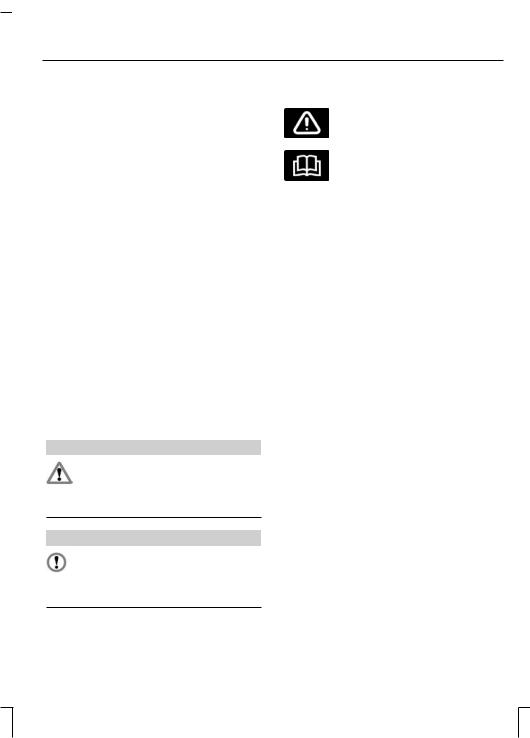
Introduction
ABOUT THIS HANDBOOK
Thank you for choosing Ford. We recommend that you take some time to get to know your vehicle by reading this handbook. The more that you know about it, the greater the safety and pleasure you will get from driving it.
Note: This handbook describes every model and option, sometimes even before they are generally available. It may describe options not fitted to your vehicle.
Note: Always use and operate your vehicle in line with all applicable laws and regulations.
Note: Pass on this handbook when selling your vehicle. It is an integral part of the vehicle.
SYMBOLS GLOSSARY
Symbols in this handbook
WARNING
You risk death or serious injury to yourself and others if you do not follow the instructions highlighted
by the warning symbol.
CAUTION
You risk damaging your vehicle if you do not follow the
instructions highlighted by the caution symbol.
Symbols on your vehicle
When you see these symbols, read and follow the relevant instructions in this handbook before touching or attempting adjustment of any kind.
PARTS AND
ACCESSORIES
Genuine Ford parts and accessories have been designed specifically for your vehicle. Unless we have specifically stated, we have not tested non-Ford parts and accessories and, therefore, we will not guarantee that they are suitable for your vehicle. We recommend that you ask your Ford Dealer for advice on parts and accessories suitable for your vehicle.
5

Quick start
Unlocking |
Press the unlock button on the |
Transit Connect |
remote control twice within three |
seconds to unlock all doors. |
E74805
Position 1 once to unlock both front doors.
Position 2 twice to unlock all doors.
Rear door: turn clockwise to unlock.
E74801
Press the unlock button on the remote control once to unlock both front doors.
E66522
Press the cargo unlock button on the remote control once to unlock the rear doors or tailgate and the sliding door(s) only.
Tourneo Connect
E74800
Position 1 once to unlock all doors. The direction indicators will flash once as confirmation.
6

Quick start
E74802
Press the unlock button on the remote control once to unlock all doors. The direction indicators will flash once as confirmation.
Locking
To activate central locking and arm the anti-theft alarm system:
E74803
Turn to position 2.
E66524
Press the lock button on the remote control once. On vehicles without double locking, the direction indicators will flash twice as confirmation.
To activate double locking and arm the anti-theft alarm system:
E74805
Turn the key in a front door to position 1 and then to position 2 within three seconds.
7

Quick start
Central or double locking can also be activated from the rear door. Turn the key in the direction shown for the front right-hand door.
E66524
Press the lock button on the remote control twice within three seconds. The direction indicators will flash twice as confirmation.
Setting the clock
Version 1
E74265
AToggle and reset button
•Turn the ignition to position II.
•Hold the button A pressed for at least three seconds until the time in the display flashes.
•To advance the minutes, press the button A. To advance rapidly, hold the button pressed.
To toggle between 12 or 24 hour format, turn the ignition to position I and press the button A.
Version 2
For detailed instructions on how to adjust the clock, refer to the separate audio manual.
E83530
Press button A to show the time.
Windscreen defrosting or demisting
E74666
8

Quick start
Select the maximum temperature, set the air distribution control to the windscreen and set the blower to position 4. Air conditioning will be switched on automatically to support defrosting or demisting. If necessary, turn the heated windscreen and heated rear window on.
9
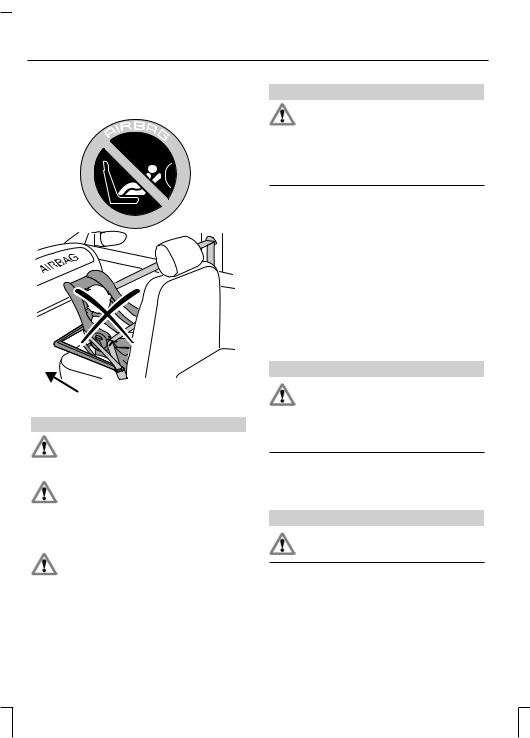
Child safety
CHILD SEATS
E72336
WARNINGS
Extreme Hazard! Do not use a child restraint on a seat
protected by an airbag in front of it!
Original text according to ECE R94.01: Extreme Hazard! Do not use a rearward facing child restraint
on a seat protected by an air bag in front of it!
There is a risk of death or serious injury when the airbag
deploys.
WARNINGS
Always have the rear row head restraint raised when a child
restraint is being installed or occupying the seat, provided doing so does not move the child restraint away from the vehicle seat.
Note: If the vehicle has been involved in an accident, have the child safety seat checked by an expert as it might be damaged.
Note: Do not leave children unattended in the child safety seat or in the vehicle.
Note: When installing a child seat/restraint with the seat belt, always ensure belts fit without slack or twists.
WARNING
There is a risk of death or serious injury when the manufacturer’s instructions are not followed properly or when the child seat/restraint is modified in any way.
Whenever installing a child seat/restraint, always read and follow the manufacturer’s instructions.
WARNING
Do not hold a child on your lap while the vehicle is moving.
10

Child safety
Children of height 150 cm or under or aged 12 years or under should be secured in special restraints for children, such as baby seats, child safety seats or booster cushions in the rear seats.
Such equipment must be suitable and government approved (depending on country).
A choice of ECE approved child restraints is available at your Ford Dealer. Please ask for the recommended child seats. Together with the adult seat belt, these restraints help to provide maximum security for the children.
Child restraints for different mass groups
The correct restraint to be used depends on the child’s age and weight:
Baby safety seat
E72337
Babies under 13 kg (approximately 18 months) are best protected if properly restrained in rearward facing baby safety seats (Group 0+) on the rear seat.
Child safety seat
E72338
Children weighing between 13 and 18 kg (approximately nine months to four years old) should be carried properly restrained in child safety seats (Group I) in the rear seat.
CHILD SEAT
POSITIONING
WARNINGS
If your Ford vehicle is equipped with a front passenger airbag, children of height 150 cm or under or aged 12 years and under must only be properly restrained in the rear seat
– never in the front.
11

Child safety
WARNINGS
Extreme Hazard! Do not use a rearward facing child restraint on a seat protected by an airbag in
front of it!
Note: If individual circumstances require that a child weighing more than 9 kg must travel in a front seat protected by an operational front airbag, only use a forward facing restraint.
The following table advises on the suitability of child restraint fitment locations.
Child seat positions
|
|
Mass group categories |
|
|
|||||
|
0 |
0+ |
I |
|
II |
III |
|||
|
Up to 10 |
Up to 13 |
9 to 18 |
15 to 25 |
22 to 36 |
||||
|
kg |
kg |
kg |
kg |
kg |
||||
Seating positions |
(about |
(about |
(about 9 |
(about |
(about |
||||
0− 9 |
0− 2 |
months− |
31/2 − 12 |
6− 12 |
|||||
|
|||||||||
|
months) |
years) |
4 years) |
years) |
years) |
||||
|
|
|
|
|
|
|
|||
|
Baby |
Baby |
Child |
Booster |
Booster |
||||
|
safety |
safety |
safety |
seat/ |
seat/ |
||||
|
seat |
seat |
seat |
cushion |
cushion |
||||
Front passenger |
X |
X |
U |
1 |
U |
1 |
U |
1 |
|
seat, with airbag |
|||||||||
|
|
|
|
|
|||||
Front passenger |
|
|
|
|
|
|
|
|
|
seat, without |
U |
U |
U |
U |
U |
||||
airbag |
|
|
|
|
|
|
|
|
|
Rear seats |
U |
U |
U |
U |
U |
||||
ISOfix child seat, |
N/A |
L |
L |
N/A |
N/A |
||||
second row centre |
|||||||||
|
|
|
|
|
|
|
|
||
X = Seat position not suitable for children in this mass/age group.
U = Seat position suitable for universal category restraints approved for use in this mass/age group.
12

Child safety
U1 = Seat position suitable for universal category restraints but Ford recommends that children should be secured in an appropriate child restraint in the rear seats.
L = Seat position suitable for particular child restraints approved for use in this mass/age group.
N/A = Not applicable.
13

Child safety
BOOSTER CUSHIONS
Children weighing more than 15 kg and under 150 cm should use a booster seat or booster cushion. Ford recommends using booster seats that combine a booster cushion and a back rest into one seat for children between 15 and 25 kg. The raised seating position ensures that the adult seat belt can be correctly guided over the centre of the shoulder instead of along the neck, the lap belt lying tightly across the hips instead of the stomach. Make sure that your child sits in an upright position.
E72362
ABooster seat
BBooster cushion
WARNINGS
You should never use a booster seat with only a lap belt.
Never put the shoulder belt under a child’s arm or behind
the back.
Never use pillows, books, or towels to boost a child.
14
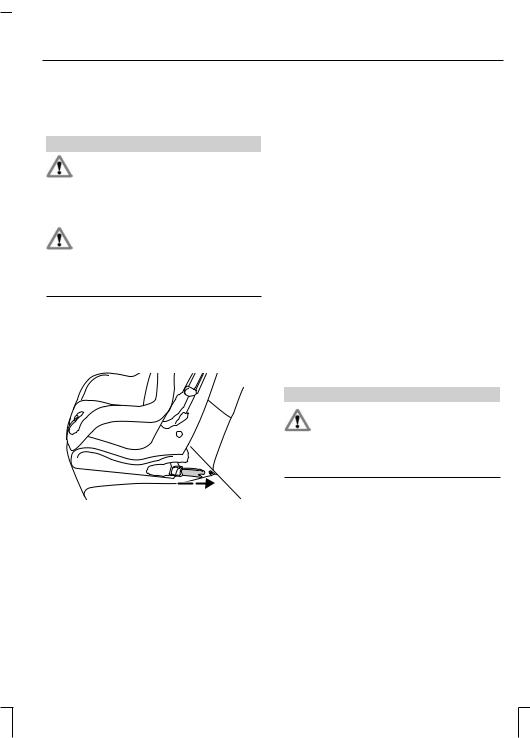
Child safety
ISOFIX ANCHOR POINTS
Tourneo Connect
WARNINGS
Ford does not recommend the use of an ISOfix system without
the use of an anti-rotation device, such as a top tether anchor or support leg, correctly installed.
There is a risk of death or serious injury when the manufacturers instructions are not followed properly or when the child
restraint is modified in any way.
Your vehicle has been equipped with ISOFIX anchor points. Your Ford Dealer will be pleased to make them accessible.
E75769
The ISOFIX system consists of two rigid latching arms on the child seat which attach to anchor points at the bottom of the seat. When made available by your Ford Dealer, the two lower anchor points may be found on the second row centre seat and are labelled with a circular pictogram and the text ‘ISOFIX’. The guides enable the latching arms of an ISOFIX child seat to be easily and securely attached.
ISOFIX child seats not approved by Ford have not been validated by Ford, and neither the suitability nor the safety of such seats can be certified, whether installed using the ISOFIX system or the normal seat belts.
Attaching a child seat with top tethers
WARNING
Attach the tether strap only to the appropriate tether anchor as shown. The tether strap may not
work properly if attached somewhere other than the correct tether location.
A third anchor point has been provided for child seats that are equipped with a top tether, available for use in the forward facing configuration. This additional anchor will enable the use of a top tether strap. Contact your Ford Dealer to have this anchor installed.
15

Child safety
E75770
On vehicles with five seats, the anchor is located at the top of the rear door opening.
E75771
On vehicles with eight seats, it is located on the rear of the second row centre seat.
E75772
The anchor point is identified by a pictogram. The tether strap should be routed beneath the raised head restraint to the anchor point. Remove the anchor point cover and attach the strap. After installing the child safety seat, tighten the tether strap according to the manufacturer’s instructions.
16
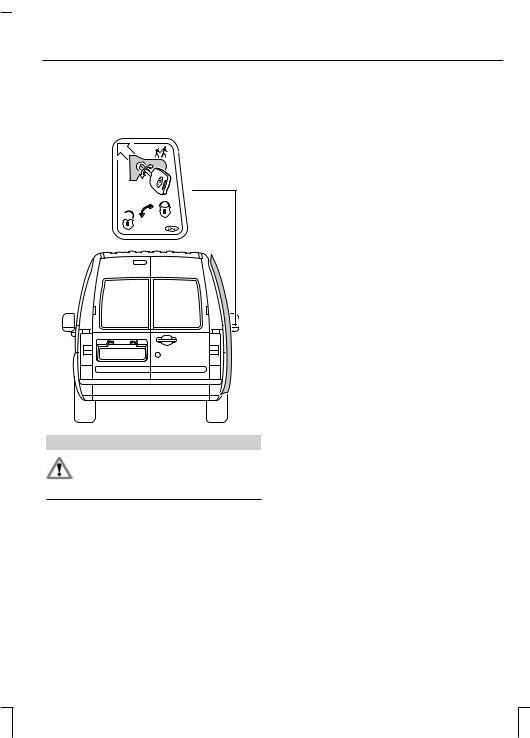
Child safety
CHILD SAFETY LOCKS
Tourneo Connect
E75766
WARNING
When the child safety lock is activated, the door can only be
opened from outside.
Note: Child safety locks are only fitted to sliding doors.
Using the ignition key, turn the safety lock lever on the end of the door outwards. The door cannot be opened from inside the vehicle.
To deactivate the lock, turn the safety lock lever inwards.
17

Occupant protection
PRINCIPLE OF OPERATION
Airbags
E75574
WARNING
Do not modify the front of the vehicle in any way, as this can
adversely affect the airbag deployment.
Note: A loud bang will be heard when an airbag deploys and it is normal to see a cloud of harmless powdery residue.
The airbag system comprises the following:
•driver and front passenger inflatable nylon bags (airbags) with gas generators.
•side airbags
•curtain airbags
•a seat belt pretensioner
•crash sensors.
•a warning lamp in the instrument cluster.
•an electronic control and diagnostic unit.
E72330
18

Occupant protection
WARNINGS
Repairs to either of the front seat covers or the sensors attached to the seats should only be
carried out by properly trained technicians. Injuries may result if the side airbags are triggered inadvertently.
Do not block, obstruct or cover the airbag because it may
prevent proper deployment. Do not poke any sharp objects into the areas where airbags are fitted. This could damage the airbags.
Do not use any accessory seat covers that are not specifically designed for seats with side airbags. These seat covers must be fitted by
properly trained technicians.
WARNING
Always wear the seat belt and keep sufficient distance
between the driver and the steering wheel. Only when the seat belt is used properly, can it hold the body in a position which allows the airbag to achieve its optimum effect. There is a risk of injury when the airbag deploys.
The seat and back must be set correctly for the airbags to be optimally effective. See Sitting in the correct position (page 74).
This is the ideal seating position for the driver and front passenger and helps reduce the risk of injury from sitting too close to an inflating airbag.
E66553
E75575
The front airbags activate during significant collisions which are either frontal or up to 30 degrees from the left or the right. The airbags inflate within a few thousandths of a second. They will deflate on contact with the front occupants thus cushioning forward body movement.
19

Occupant protection
These areas should only be wiped with a damp cloth, never with a wet cloth.
Side air bags
E75576
During minor collisions as well as overturns and rear or side collisions, the front airbag system will not be activated.
E72328
A label on the seatback indicates that side airbags are fitted. The side airbags are fitted on the side of the seatbacks of the front seats. In case of a severe lateral collision, the airbag on the side affected by the collision will be inflated.
E75577
WARNINGS
Repairs to the steering wheel, steering column and airbag
system should be carried out by properly trained technicians.
Always keep the areas in front of the airbags free. Never affix
anything to or over these areas.
20

Occupant protection
Seat belt pretensioner
E75578
The airbag will inflate between the door panel and occupant and above the door panel trim to provide protection to the head and rib areas. Once the occupant’s body contacts the airbag, the propellant escapes, thereby cushioning the impact.
The side airbags are not activated upon minor lateral collisions nor upon front or rear impacts.
Seat belts
WARNINGS
 Use seat belts at all times.
Use seat belts at all times.
Never use a seat belt for more than one person.
 Avoid wearing thick clothing.
Avoid wearing thick clothing.
The seat belts should fit tightly around the body.
E72333
WARNING
The belt pretensioners must not be removed. If the
pretensioners deployed during an accident, they must be replaced. Have the pretensioners serviced and disposed of by specially trained personnel only.
The restraint system, with belt pretensioner in the driver’s seat belt, helps to reduce the risk of serious injury in a major frontal impact. During a serious crash the driver’s seat belt is pretensioned to help reduce slack in the belt. The safety belt pretensioner is a device which removes excess webbing from the safety belt system. When the safety belt pretensioner deploys, webbing from the lap and shoulder belt is tightened.
The belt pretensioner is not triggered in any side, rear or minor frontal collisions.
21

Occupant protection
FASTENING THE SEAT |
Rear seat belts |
BELTS |
|
E66541
WARNING
Insert the tongue into the buckle until a distinct click is heard,
otherwise the seat belt will not be locked correctly.
Pull the belt out steadily. It may lock if pulled sharply or if the vehicle is on a slope.
To release the belt, press the red button on the buckle and let the belt rewind completely and smoothly.
E75564
WARNING
In order to ensure that the centre belt works properly, the
rear seatback must be correctly engaged.
Make sure that each seat belt uses the correct buckle.
22

Occupant protection
SEAT BELT HEIGHT |
USING SEAT BELTS |
ADJUSTMENT |
DURING PREGNANCY |
Front seat belt |
|
E68901
Rear seat belt
E73074
WARNING
Make sure that the seat belt runs smoothly through the
guide.
E68587
WARNING
Position the seat belt correctly for your safety and that of your unborn child. Do not use only the lap
strap or the shoulder strap.
Position the lap strap comfortably across your hips and low beneath your pregnant abdomen. Position the shoulder strap between your breasts, above and to the side of your pregnant abdomen.
23

Keys and remote controls
GENERAL INFORMATION ON RADIO FREQUENCIES
CAUTION
The radio frequency used by your remote control can also be
used by other short distance radio transmissions (e.g. amateur radios, medical equipment, wireless headphones, remote controls and alarm systems). If the frequencies are jammed, you will not be able to use your remote control. You can lock and unlock the doors with the key.
Note: You could unlock the doors if you press the buttons on the remote control unintentionally.
The operating range between your remote control and your vehicle varies depending on the environment.
PROGRAMMING THE REMOTE CONTROL
A maximum of four remote controls (including the ones supplied with the vehicle) can be programmed.
E74806
A Transit Connect
BTourneo Connect
Note: Ensure that the anti-theft alarm is deactivated and that all doors are closed.
•To programme new remote controls, turn the ignition key from position 0 to position II eight times within 10 seconds. The ignition must end in position II and remain in this position. The door locks will cycle to indicate that it is now possible to programme new remote controls.
•Press any button on a new remote control within 20 seconds of the door locks cycling. The door locks will cycle again to indicate that the remote control has been successfully programmed.
24

Keys and remote controls
•Repeat step 2 for all your remote controls, including your original remote control. Each time a new remote control is successfully programmed, the programming period starts again and it is possible to programme a new remote control for 20 seconds.
•Turn the ignition to position 0. The door locks will cycle to indicate that the remote control programming is ended. Only the remote controls which you have just programmed are now able to lock and unlock your vehicle.
CHANGING THE REMOTE CONTROL BATTERY
If the range of the transmitter in the key decreases gradually, the battery (type 3V CR 2032) should be replaced.
•Open the transmitter unit by separating the sides with a flat object.
•Carefully prise out the battery with the flat object. Fit the new battery between the contacts with the + sign facing downwards.
Reassemble the transmitter unit in reverse order.
E66527
25
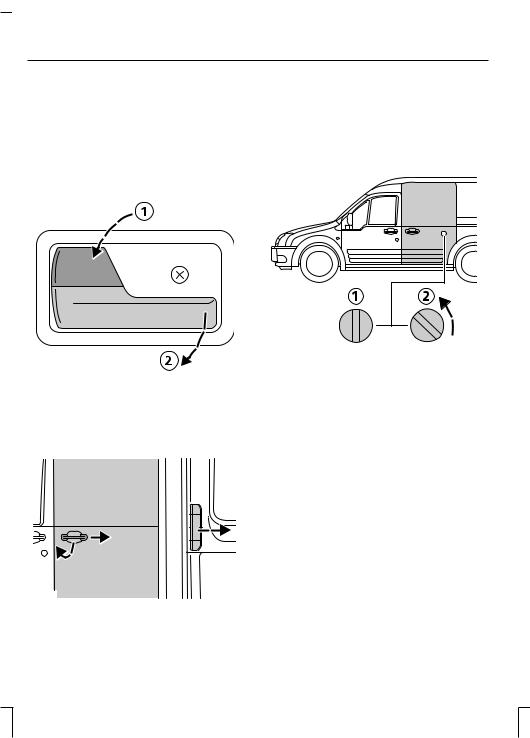
Locks
LOCKING AND
UNLOCKING
Front doors
The front doors can be locked and unlocked from the outside with the key or the remote control.
Note: On Tourneo Connect, the right-hand sliding door is inhibited from opening fully when the fuel filler flap is unlocked and open.
To open, pull the door handle and then slide the door backwards.
E74704
When inside the vehicle, they can be locked with the locking lever 1 and unlocked using the door handle 2.
Sliding door
E74705
E74706
To manually lock the sliding door, turn the locking knob on the inside of the door to the locked position 1. To unlock turn it to the unlocked position
2.
26

Locks
Double rear doors
E74707
WARNING
Close the rear doors properly to prevent them from opening
while you are driving. Driving with the rear doors open is extremely dangerous as exhaust fumes can be drawn into the vehicle’s interior.
To open the right-hand rear door from the outside, pull the door handle. To unlock and open the right-hand door from the inside, push the emergency release lever to the left.
E74708
To open the left-hand rear door, pull the door handle.
E74709
Both doors can be opened through 180 degrees. Once the 90 degree position is reached, push the yellow button located on the door. The check arms will automatically re-engage when the doors are closed.
27

Locks
E74710
Some models have rear doors that can be opened through 250 degrees. Once the 90 degree position is reached, push the yellow button located on the door. The check arms will automatically re-engage when the doors are closed.
Tailgate
B
A
E66517
WARNING
Close the tailgate properly to prevent it opening while you are
driving. Driving with the tailgate open is extremely dangerous as exhaust fumes can be drawn into the vehicle’s interior.
To open, pull the door handle A located above the number plate. The tailgate can be opened from inside by moving the release button B upwards, which is accessible through the aperture at the bottom of the tailgate.
Central locking
E74798
28
